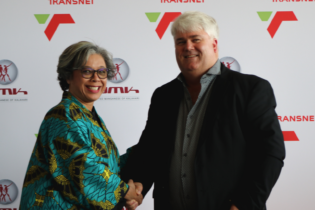Transnet expects to double grain tonnages transported over the seven years of its expansion plan. Even so, this will still fall short of industry requirements.
Albert Swart, Transnet Freight Rail (TFR) executive manager of sales & marketing for agriculture, says that over time TFR may come close to meeting the requirements of the maize industry, but will not be able to do it overnight. TFR transported 3.3 Mt of grain last year — or just over 20% of South Africa’s 15 Mt production total. The rest was transported by road. Swart admits there has been a drop in tonnages transported by Transnet over the past few years. He ascribes this to unreliable rolling stock and outdated locomotives. Although TFR will be allocated R201 billion of the R300 billion expansion budget, most grain and other agricultural produce will still have to be transported by road. Of the R201 billion, R77.2 billion will be for new locomotives, R76.7 billion for infrastructure improvements and R47.1 billion for new trucks. “The grain industry is low on the list of Transnet’s priorities,” says Annatjie Loio, president of the Grain Handling Organisation of Southern Africa. “Transnet is more geared towards loading mining commodities at a single point and delivering it to a port.” “For instance, with grain, there are 10 trucks to load at Bothaville, 17 at Hertzogville and 12 at another stop. Then there are stops all along the way to offload, and so on. Nonetheless, because we are dealing with food, it is vital that grain be transported as cheaply as possible to where it is needed”, says Loio. But, for Transnet this would mean maintaining a network of branch lines. Given the cost overheads and financial non-viability, this does not match Transnet’s strategy of commercial viability – hence its strategy to privatise branch lines. It is a lot simpler, and more cost effective, transporting mining commodities from one point of pick up to one point of delivery.Despite these economic realities, Loio insists that Transnet will have to come to the party as the grain industry enters a new growth phase. This was initiated by the export of more than 2 Mt of grain during the past season to neighbouring countries as well as Mexico, Italy, Korea, Venezuela, Kuwait, Iran, Japan, Madagascar and Taiwan.
“In the sub-Saharan region there is a population of one billion people that must be fed. There are also huge opportunities with South Africa being one of the BRICS countries, which have a total population of almost three billion people.” Economist Roelof Botha says the BRICS countries consume US$2 trillion (R16.6 trillion) worth of food every year, which is about 34 times South Africa’s total agricultural yield. Loio says the South African grain industry will “definitely” play an even bigger role in the future in feeding the region due to its “privileged position with regard to storage capacity and infrastructure”. But though the South African industry is able to receive, handle, fumigate, dispatch and store in its silos the 15 Mt of grain produced, it is forced to transport about 80% of this by road. “The proportions used to be 90% rail and 10% road, now it is almost the other way around,” says Loio. “It is expensive and increases traffic. Heavy trucks add to the wear on the roads.” A solution must be found.






